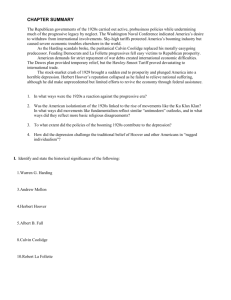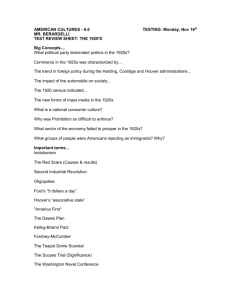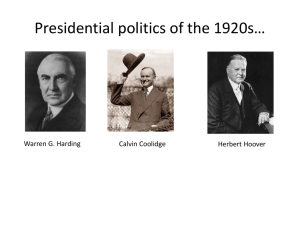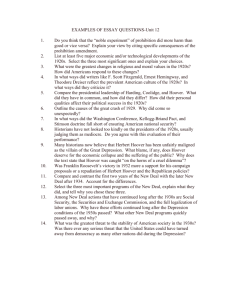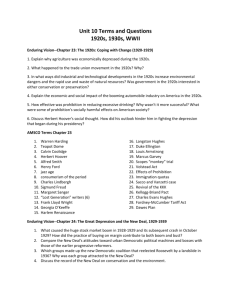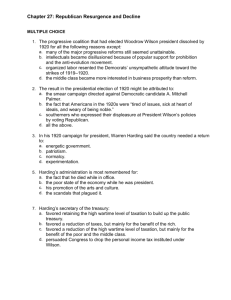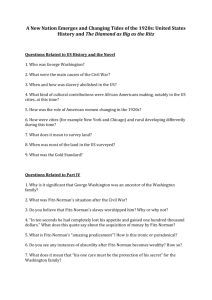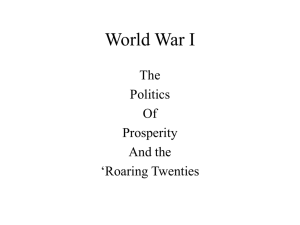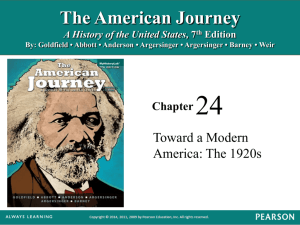Multiple-Choice Questions - chapter 26 1. The “Ohio gang”: A
advertisement
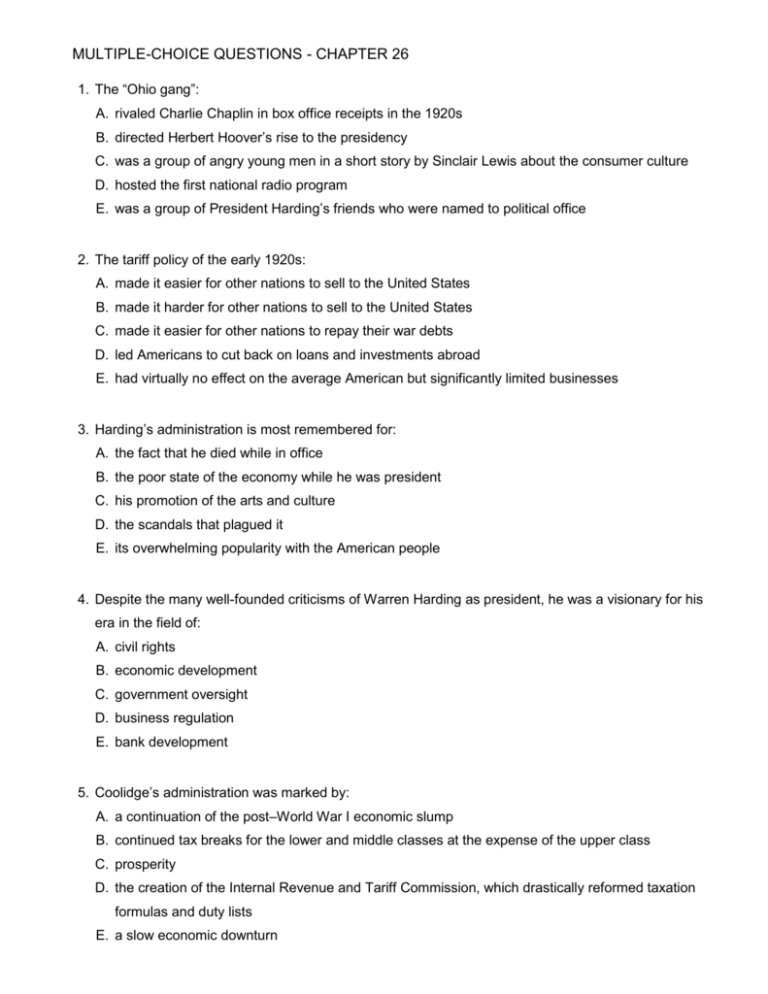
MULTIPLE-CHOICE QUESTIONS - CHAPTER 26 1. The “Ohio gang”: A. rivaled Charlie Chaplin in box office receipts in the 1920s B. directed Herbert Hoover’s rise to the presidency C. was a group of angry young men in a short story by Sinclair Lewis about the consumer culture D. hosted the first national radio program E. was a group of President Harding’s friends who were named to political office 2. The tariff policy of the early 1920s: A. made it easier for other nations to sell to the United States B. made it harder for other nations to sell to the United States C. made it easier for other nations to repay their war debts D. led Americans to cut back on loans and investments abroad E. had virtually no effect on the average American but significantly limited businesses 3. Harding’s administration is most remembered for: A. the fact that he died while in office B. the poor state of the economy while he was president C. his promotion of the arts and culture D. the scandals that plagued it E. its overwhelming popularity with the American people 4. Despite the many well-founded criticisms of Warren Harding as president, he was a visionary for his era in the field of: A. civil rights B. economic development C. government oversight D. business regulation E. bank development 5. Coolidge’s administration was marked by: A. a continuation of the post–World War I economic slump B. continued tax breaks for the lower and middle classes at the expense of the upper class C. prosperity D. the creation of the Internal Revenue and Tariff Commission, which drastically reformed taxation formulas and duty lists E. a slow economic downturn 6. In the 1920s, farm prices: A. were subsidized by the federal government B. stayed at their high wartime levels C. stayed at their low wartime levels D. fell sharply E. rose sharply 7. The McNary-Haugen bill: A. called for surplus crops to be sold on the world market in order to raise domestic prices B. failed to pass Congress in 1922 but passed in 1927 with the support of President Coolidge C. effectively raised domestic commodity prices D. was viewed with derision by American farmers E. ushered in a new golden age of American agriculture 8. Which of the following is NOT true of the “American plan” concept of employment? A. It originated in Chicago. B. It allowed employers to hire nonunion workers. C. It established open shops. D. It could be effectively used to discriminate against unions. E. It promised a more democratic work environment than most other shops. 9. In response to the Bonus Army marchers, Herbert Hoover: A. got Congress to approve immediate payment of their bonuses B. put them to work building schools and roads C. sent the U.S. Army to evict them D. promised them that prosperity was just around the corner E. met with them personally at the White House to hear their concerns 10. In “yellow-dog” contracts, employers: A. agreed to submit all grievances to an arbitration panel whose decision was binding B. forced workers to agree to stay out of unions C. agreed to hire only union workers D. forced workers to sign a statement that they would vote the Democratic ticket E. agreed to automatic wage increases in return for the workers’ promise not to strike 11. In the 1920s, labor unions: A. won a number of important victories in the Supreme Court B. gained about 1.5 million members C. lost about 1.5 million members D. were helped by the prosperity of the decade E. enjoyed the support of Republican presidents 12. Part of the reason for the stock market crash was: A. the high rate of deflation in the 1920s B. the tax policies of the 1920s that hurt the wealthy, who might otherwise have bought more stocks C. the buying of great amounts of stock on margin D. the low tariff, which allowed imports to corner several important American markets E. the remarkably poor returns on government bonds in 1929 13. Which of the following was NOT a cause of the Depression? A. The gold standard caused a tightening of currency supplies worldwide. B. Corporate structures had been bloated by the success of the 1920s but were unprepared for the tightening of the economy. C. Mellon’s business-friendly tax policies enticed the rich into more frenzied stock market speculation. D. Much of the profits that had been taken during the 1920s had been put back into companies rather than saved or invested in other ways. E. As consumer spending declined, the rate of investment in new factories and businesses also plummeted. 14. Of all the causes of the stock market crash of October 1929, the greatest culprit was: A. Hoover’s tax policies B. the weak foundation of the 1920s economy C. international monetary policy D. unethical practices on Wall Street E. union influences on business 15. Herbert Hoover, while attempting to shore up the economy through economic policy, considered what to be the thing Americans needed most at the time? A. cash B. food C. welfare D. confidence E. private investment 16. The Emergency Relief Act: A. gave direct aid to individuals suffering during the Depression B. refused to allow any state to give aid C. was passed only after the vice president broke a tie in the Senate D. avoided a direct dole to individuals E. provided state but not local aid 17. Just before his election to the presidency in 1932, Franklin D. Roosevelt was serving as: A. secretary of state B. vice president C. governor of New York D. national chairman of the Democratic party E. a professor at West Point 18. Whose campaign song was “Happy Days Are Here Again”? A. Al Smith B. Herbert Hoover C. Franklin D. Roosevelt D. Eugene Debs E. Theodore Roosevelt

